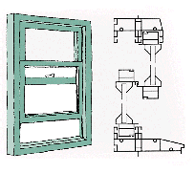|
 |
| FIG.
1 - Single- and double-hung vinyl windows are popular choices
for replacing old wood windows. They fit into the sash opening,
so they can be installed without removing the entire window. Although
vinyl itself is not a great insulator, vinyl window frames are nearly
as effective as wood, because the multiple chambers in the extrusion
(right) create dead air space that slow heat transfer. |
|
|
|
| FIG.
2 - Vinyl windows come in a variety of shapes and styles. |
|
|

VINYL REPLACEMENT WINDOW BASICS
- It wasn't too long ago that vinyl windows were considered
a less-than-ideal choice for replacement windows. But advances in
design plus improvements in the formulation of polyvinyl chloride
(PVC) have made vinyl windows a high-quality product that competes
favorably with wood.
- Vinyl windows have always had some advantages over
aluminum and steel. Metal is a highly efficient heat conductor–a
great property when it comes to pots and pans, but not so slick when
you're talking about window frames. As window glazing has improved,
the difference in insulating value between the glass and the frame
of a metal window became greater and greater.
- PVC, on the other hand, is a nonconductor of heat.
It doesn't truly insulate like wood, but the design of a vinyl window
adds greatly to the frame's insulating value. The primary reason that
insulating glass works is because there is a pocket of trapped air,
called dead air space, between the inner and outer panes. Vinyl window
frames work on the same principle. The frames are hollow, built with
multiple chambers to add strength (Fig. 1). Those chambers also trap
air and thereby slow heat transfer.
- Good quality vinyl windows are nearly equal to wood
windows in their overall insulating value, but not just because of
the frames. Compared to old shop-built wood double-hung windows, the
factory weather-stripping in modern vinyl windows allows only a fraction
of the air leakage around the sash. As a rule, air infiltration is
even more important than insulating quality in preventing heat loss.
- Vinyl windows come in a variety of styles, including
single- and double-hung (Fig. 1), horizontal sliding (Fig. 2), casement,
awning and hopper. Sliding patio doors are also available. The color
is part of the PVC formula, so vinyl windows never have to be painted.
Most come in white and almond, some with wood grain overlays inside.
- Vinyl windows offer the same style features found
on other top-quality windows–divided light grids, decorative
glass, tilt-out sash on single- and double-hung units, high-efficiency
locking systems, premium configurations such as circle tops, bay and
bow units and even brass hardware. Like all vinyl products, they are
also maintenance-free.
- A few manufacturers still make dark brown windows,
but many have stopped manufacturing dark colors. Despite advances
in formulation, vinyl is still more sensitive to temperature variations
than other window materials, and dark colors absorb heat more readily
than light colors.
|










